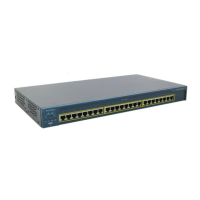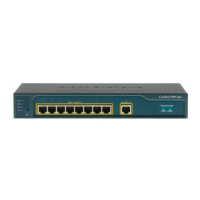CHAPTER
13-1
Catalyst 2950 and Catalyst 2955 Switch Software Configuration Guide
78-11380-12
13
Configuring STP
This chapter describes how to configure the Spanning Tree Protocol (STP) on port-based VLANs on
your Catalyst 2950 or Catalyst 2955 switch. The switch can use either the per-VLAN spanning-tree plus
(PVST+) protocol based on the IEEE 802.1D standard and Cisco proprietary extensions, or the rapid
per-VLAN spanning-tree plus (rapid-PVST+) protocol based on the IEEE 802.1w standard.
For information about the Multiple Spanning Tree Protocol (MSTP) and how to map multiple VLANs
to the same spanning-tree instance, see Chapter 14, “Configuring MSTP.”
For information about other spanning-tree features such as Port Fast, UplinkFast, root guard, and so
forth, see Chapter 15, “Configuring Optional Spanning-Tree Features.”
Note For complete syntax and usage information for the commands used in this chapter, see the command
reference for this release.
This chapter consists of these sections:
• Understanding Spanning-Tree Features, page 13-1
• Configuring Spanning-Tree Features, page 13-11
• Displaying the Spanning-Tree Status, page 13-24
Understanding Spanning-Tree Features
These sections describe how basic spanning-tree features work:
• STP Overview, page 13-2
• Spanning-Tree Topology and BPDUs, page 13-2
• Bridge ID, Switch Priority, and Extended System ID, page 13-3
• Spanning-Tree Interface States, page 13-4
• How a Switch or Port Becomes the Root Switch or Root Port, page 13-7
• Spanning Tree and Redundant Connectivity, page 13-8
• Spanning-Tree Address Management, page 13-8
• Accelerated Aging to Retain Connectivity, page 13-8
• Spanning-Tree Modes and Protocols, page 13-9
• Supported Spanning-Tree Instances, page 13-9

